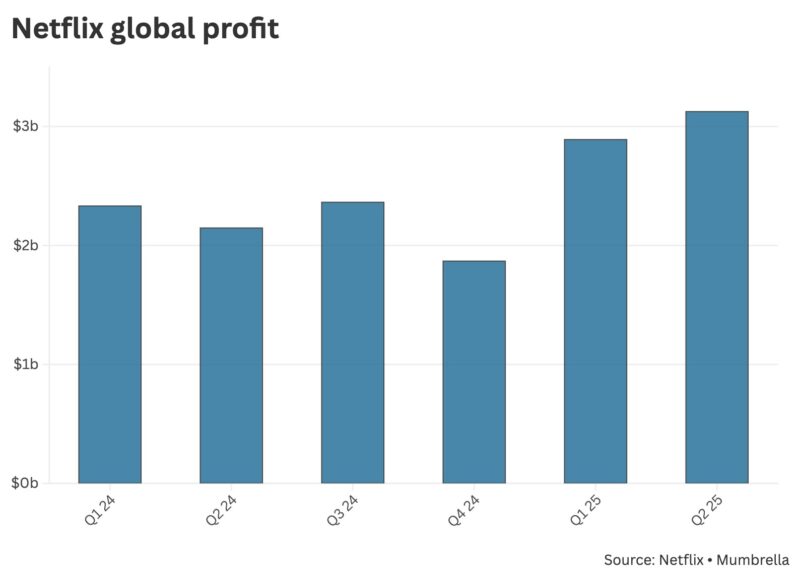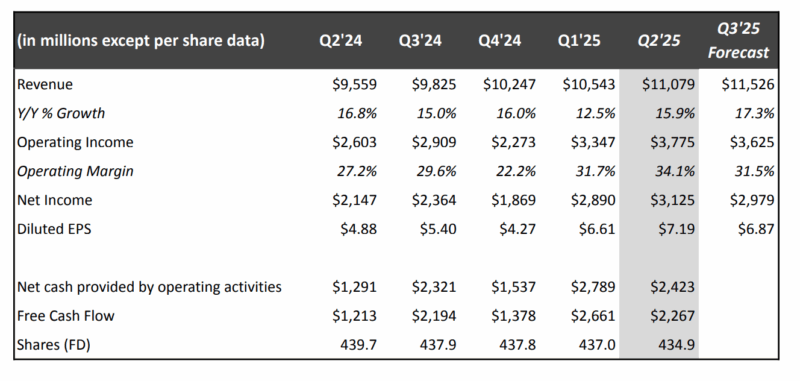
Netflix CFO credits ongoing success to building assets, not buying them

Squid Game is a Netflix-owned property.
“More members, higher subscription pricing and increased ad revenue”: the reasons for Netflix’s 16% leap in revenue for the second quarter of 2025 seem obvious when stepped out in the company’s recent presentation, but behind the company’s incredible continued growth is a simple strategy to build assets rather than buying them.
Netflix posted revenue of US$11.08 billion (A$17.03b) for the June quarter, ahead of Wall Street estimates of US$11.07 billion, and up 15.9% year-on-year. Net income (profit) was US$3.13 billion (A$4.76b) up from US$2.15 billion, with every region enjoying double digit revenue growth. See the graph below for trended profit over the past six quarters.

Netflix’s quarterly profits hit an all-time high in the latest quarter
The company also raised its revenue guidance for the full-year to be in the range of US$44.8 billion to US$45.2 billion, up from US$44.5 billion, which “primarily reflects the weakening of the US dollar vs. most other currencies, plus healthy member growth and ad sales.” This indicates full-year revenue growth of 17%.
The company’s operating margin sits at 34.1%, up from 27.2% a year prior, although it warned that in the second half of 2025, this “will be lower than the first half due to higher content amortisation and sales and marketing costs associated with our larger second half slate.”
This led to shares dropping by 1.9% after trading ended.
This also marks the second quarter in which Netflix has not given out total subscriber numbers, despite the claim in its presentation that “we lead the industry in viewing transparency.”
The company did reveal the final season of its in-house production Squid Games has been watched by 122 million viewers in the weeks since its late June release. Netflix users watched over 95 billion hours of content on the service during the first half of the year, a modest 1% increase, with non-English language programming making up more than one-third of all viewing.
Also gaining a mention in the shareholder letter was the company 18 nominations at the Logie Awards in Australia.
Netflix also expects “to roughly double ads revenue in 2025” after completing the rollout of its in-house first-party ad tech platform in all markets, adding that “early results are in-line with our expectations.” No ad revenue numbers were provided.
The update adds: “We believe our ad tech platform is foundational to our long-term ads strategy and, over time, will enable us to offer better measurement, enhanced targeting, innovative ad formats and expanded programmatic capabilities.
Netflix reiterated its content strategy in both the shareholder letter and during the earnings call.
“At Netflix, our content strategy is ‘local for local’ —developing shows and films that deeply connect with audiences in their home countries,” the company said.
“To achieve this, we have creative teams around the world collaborating with local talent to produce stories that reflect their cultures and interests.”
Netflix is investing “roughly US$1 billion” to develop a production facility in the US, and has signed Adam Sandler to a long term, $250 million production deal, which will see him deliver his ninth film for the streamer — Happy Gilmore 2 — during what the company calls an “unusually second-half weighted” end to the year.
In addition, Netflix has invested in animated series Asterix & Obelix: The Big Fight from France, and K Pop Demon Hunters, a Korean animation that has seen its soundtrack, featuring fictional pop stars, cross over into the Billboard charts.
Chief Financial Officer Spencer Neumann said Netflix was “choosy” about acquiring content from other media companies, preferring instead to create its own assets.
“We’ve historically been more builders than buyers,” he said during an earnings call.
“We continue to see big runway for growth without fundamentally changing that playbook.”





